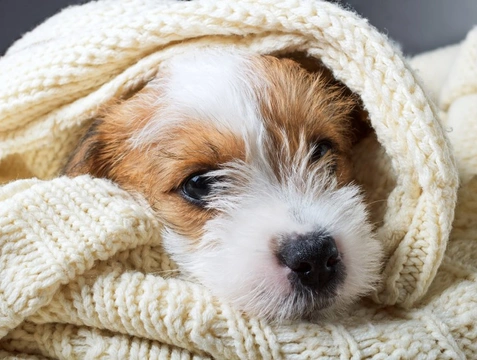
How can you tell if your dog is warm enough in the winter?
We as humans are able to control our own environments significantly, which enables us to maintain a comfortable body temperature and counteract the effects of the weather. When it is cold we stay indoors, put the heating on, bundle up well when we do go out, and enjoy warming meals and drinks. When the weather is hot we dress for the weather, enjoy cool drinks, seek shade, and use fans and air conditioning; and whilst we are all uncomfortably cold or hot sometimes on occasion too, this is something that we can address ourselves.
Because we provide for our dog’s needs and their lifestyles and comfort are dictated by the care that we give to them, dogs have a lot less control over their own environments, and what you consider to be a nice temperature may potentially be too cold or warm for your dog.
Whilst dogs can cool down by panting, drinking water and seeking shade and keep warm in winter by growing in a thicker coat and seeking warmth, this is about the limit of it; and so it is important for all dog owners to be able to assess how comfortable their dogs are when the weather is cold, and ensure that they stay warm enough.
All dogs are different, and so what is right for one dog might not be right for another; and this also means that there is no one size fits all rule for what constitutes “warm enough” that suits all dogs.
In this article we will explain how you can tell if your dog is warm enough in the winter, and share some tips on helping to keep them comfortable, whatever the weather.
How well equipped for the cold is your dog?
There are a huge range of different dog breeds and types that can be found here in the UK, which come from virtually every country and climate in the world. Some dogs have evolved to live in cold climates and some in warmer ones, and of course, it is these latter dogs that are the most poorly prepared for cold weather.
If your dog is a mixed breed or you’re not sure of their origins, the type of fur they have can help you to work this out. If your dog’s coat is short, single-layered and not overly dense, they’re probably better equipped for warm weather, whilst dogs with thicker, denser coats, particularly those that have more than one layer, densely furred legs, and that grow a much thicker coat in winter probably come from a colder place.
How old is your dog?
Healthy, adult dogs are more able to maintain their own body temperature and stay comfortable than those that are elderly, puppies, or not in peak health and condition.
Older dogs, pups, those that are underweight and those with certain types of health conditions tend to be less able to stay warm in winter (and cool in summer) and will have a harder time keeping their core temperature stable.
How to tell if your dog is cold out on walks
Going from indoors to outdoors when the weather is cold can be a bit of a shock to the system, but if your dog is coping well with the cold, they will adjust and become comfortable again within a few minutes of beginning their walk.
If your dog is cold when out walking, there are a number of ways that you can tell this:
- Your dog shivers.
- Your dog isn’t overly keen to be out, and speeds up when heading home.
- The base of your dog’s ears are cold to the touch.
- Your dog cries or makes a fuss when out on walks, refuses to move, and wants to go home as soon as you get out.
- A dog that is cold will also tend to hunch their body up and tuck their tail in, to try to preserve heat.
You might not see all of these indicators in all dogs, and it will also of course depend on how cold the weather is and how much your dog has exerted themselves with exercise.
If your dog does get too cold when out on walks, consider investing in a warm, waterproof dog coat and even potentially booties for them to help to insulate them against the cold.
How to tell if your dog is cold at home
We tend to assume that if we are warm enough at home, our dogs in their fur coats will be warm enough too. This is generally true, but if you and the family are only warm because you’re bundled up in several insulating layers and your dog doesn’t have a naturally thick, warm coat, they may be too cold.
Additionally, some of us only heat the main rooms we use (which may not include rooms that the dog uses a lot) or turn the heating off at night, which may mean that your dog is cold when you are not.
Again, look for indicators such as shivering, curling up small to preserve warmth, and checking the base of your dog’s ears to get a feel for their temperature.
If your dog is cold at home for most of the winter, they will not only be unhappy but might also lose weight and condition, and be more prone to picking up coughs and colds.
Make sure that your dog’s bed is in a comfortable room and not in any drafts, and remember that if you turn the heating off at night or don’t heat all of your rooms, your dog might need help staying warm enough.



